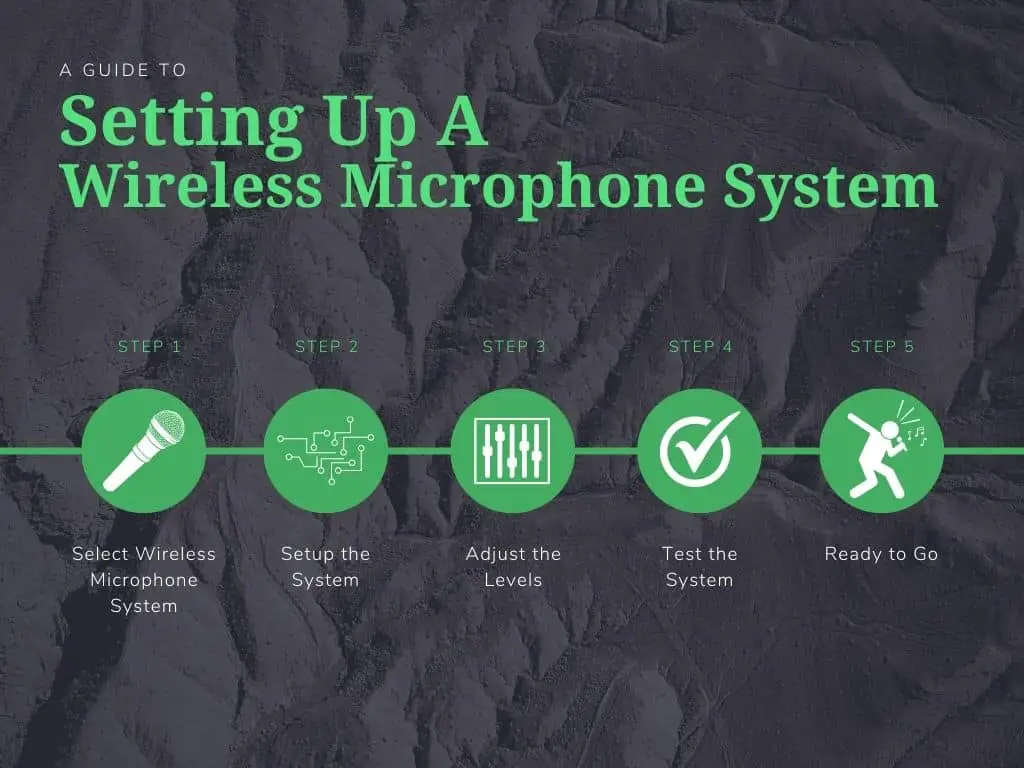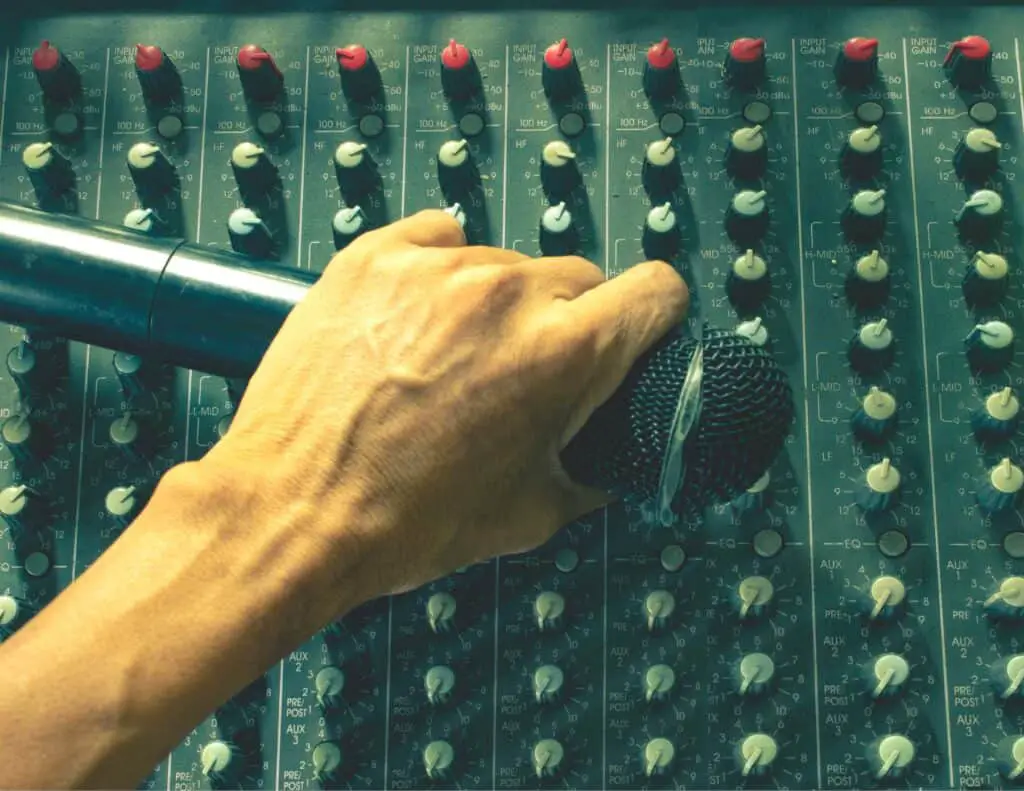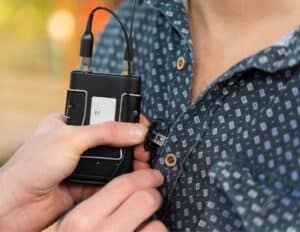
In the ever-evolving world of audio technology, 2023 brings with it a new wave of innovations in wireless microphone systems.
Whether you’re a seasoned performer or a newbie presenter, it’s essential to stay up to date so you know how to choose your next wireless microphone system or get started with your first one.
Dive into this article to discover everything you need to know about navigating the wireless microphone landscape this year.
Key Takeaways
- A wireless microphone system consists of a microphone, a transmitter, and a receiver.
- Choosing the right wireless microphone system requires understanding your specific needs and the features of different systems available.
- Factors to consider include the range, frequency response, battery life, and durability of the microphone, as well as the number of channels, frequency range, and interference resistance of the transmitter and receiver.
Table of Contents
What do you Need for a Wireless Microphone System?
A wireless microphone system consists of three components, a microphone, a transmitter, and a receiver. The microphone captures the sound and sends it to the transmitter, which then sends it wirelessly to the receiver. The receiver then sends the audio signal to your mixer, amplifier, or other sound system.
Choosing the right wireless microphone system requires understanding your specific needs and the features of different systems available.
Factors to consider include the range, frequency response, battery life, and durability of the microphone, as well as the number of channels, frequency range, and interference resistance of the transmitter and receiver.
Components of a Wireless Microphone System
A wireless microphone system consists of three fundamental components: the microphone, the transmitter, and the receiver.
- Microphone: The microphone captures the sound and converts it into an electrical signal.
- Transmitter: The transmitter sends the signal wirelessly to the receiver
- Receiver: The Receiver picks up the signal and converts it back into an audio signal that can be amplified and played through speakers.
The transmitter and the receiver communicate with each other using a specific frequency range. The frequency range used by the system depends on the type of wireless microphone system being used.
Types of Wireless Microphone Systems
There are two main types of wireless microphone systems:
- Analog: Analog systems use radio waves to transmit the audio signal. Analog systems are generally less expensive than digital systems, but they are also more susceptible to interference from other wireless devices.
- Digital: Digital systems use wireless broadband to transmit the signal. Digital systems are more expensive, but they offer better sound quality and are less susceptible to interference.
Wireless microphone systems can also be categorized based on the type of microphone being used. Handheld mics are the most common type of wireless microphone, but headset and lavalier mics are also available.
How Wireless Microphone Systems Work
A wireless microphone system is essentially a miniature radio station that replaces either a microphone cable or an instrument cable. The transmitter sends radio frequency (RF) to a receiver, which receives the signal and then sends the audio over to your mixer.
The transmitter and the receiver communicate with each other using a specific frequency range. The frequency range used by the system depends on the type of wireless microphone system being used.
To ensure that the wireless microphone system works properly, it is important to use the correct antenna. The antenna should be placed in an unobstructed location to ensure that the signal can be transmitted and received without interference.
Choosing the Right Wireless Microphone System
When it comes to choosing the right wireless microphone system, there are several factors to consider. In this section, we’ll go over some key considerations for performance, as well as different brands and models to help you make an informed decision.
Considerations for Performance
One of the most important factors to consider when choosing a wireless microphone system is its performance. Here are some key factors to keep in mind:
- Frequency Range: Look for a system that operates in the UHF (Ultra High Frequency) band of 470 – 952 MHz or VHF (Very High Frequency) band of 49 – 216 MHz. UHF systems typically offer more channels and less interference, while VHF systems are more affordable but have fewer available channels.
- Signal-to-Noise Ratio: A high signal-to-noise ratio (SNR) ensures that your audio will be clear and free from interference. Look for a system with an SNR of at least 60 dB.
- Distance and Reliability: Consider the distance you need to cover and the reliability of the system. Look for a system with a reliable transmitter and receiver that can cover the distance you need without signal dropouts.
- Encryption: If you’re using the system for broadcasting or business purposes, consider a system with encryption to protect your audio from being intercepted.
Can a Wireless Microphone Work with Any Receiver?
A wireless microphone does not work with just any receiver, even though they both might operate on the same frequency. Factors such as modulation schemes, encryption, and pilot tones may prevent wireless microphones working with different receivers.
- Protocol/Modulation Schemes: Different manufacturers (or even different models from the same manufacturer) may use different modulation schemes or communication protocols to transmit and receive signals. If the microphone and the receiver do not use the same scheme or protocol, they won’t communicate properly.
- Frequency Matching: Even if a microphone and a receiver operate within the same frequency range, they need to be tuned to the exact same frequency channel to communicate. Some systems offer automatic frequency hopping or selection to find a clear channel, but they still need to be designed to be compatible with one another.
- Encryption: Some professional-grade wireless systems use encryption to secure the audio signal. If a microphone encrypts its signal, only a receiver with the corresponding decryption key will be able to reproduce the audio clearly.
- Pilot Tone: Some wireless systems use a pilot tone—a specific frequency tone sent along with the main signal. The receiver looks for this tone to confirm that it’s receiving a signal from a compatible transmitter. If the pilot tone is missing or doesn’t match what the receiver expects, the receiver might mute the output, even if the main frequency matches.
- Dynamic Range & Compression: Some wireless microphone systems apply compression to the audio signal to fit within the available dynamic range of the wireless link. If a microphone and receiver do not use the same compression scheme or settings, the audio could sound distorted or unclear.
- Manufacturing Variations: Even if two systems are technically compatible on paper, manufacturing variations or proprietary tweaks in their design could lead to incompatibilities.
- Digital vs. Analog: Newer systems might be digital, while older ones are analog. An analog transmitter cannot communicate with a digital receiver and vice versa.
While it’s theoretically possible for a wireless microphone to work with a receiver of a different make or model, in practice it’s often not that simple. It’s generally recommended to use a microphone and receiver that are designed to work together to ensure the best performance and reliability.

Setting Up Your Wireless Microphone System
Positioning and Pairing
When setting up your wireless microphone system, it is important to consider the positioning of your microphone and the receiver.
Make sure that the microphone is close enough to the performer to capture their voice clearly, but not so close that it picks up unwanted noise or distortion.
The receiver should be placed in a location with a clear line of sight to the microphone, to ensure the best signal strength possible.
Some systems may require you to enter a code or select a frequency channel manually. Make sure to test the signal strength and quality after pairing to ensure that everything is working properly.
Volume and Sound Quality Control
Once your wireless microphone system is set up and paired, it is important to control the volume and sound quality.
Adjust the volume levels on your mixer or PA system to ensure that the sound is clear and not distorted. Be aware of latency issues, which can cause delays in the electrical impulses from the microphone to the receiver.
Consider using a condenser microphone for better sound quality, especially in a school or teaching environment where clarity is important. Check the battery levels on your microphone and body-pack regularly to avoid any unexpected dropouts or signal loss.
Troubleshooting Common Issues
Even with careful setup and testing, there may be issues that arise with your wireless microphone system. Common issues include interference from other wireless devices, signal dropouts, and distortion.
To troubleshoot interference, try changing the frequency channel or moving the receiver to a different location. Signal dropouts may be caused by low battery levels or a weak signal strength. Distortion can be caused by overloading the microphone or mixer levels.
If you are experiencing any issues with your wireless microphone system, consult the manufacturer’s instructions or seek help from a professional audio technician.
Comparing Wireless and Wired Microphone Systems
Wireless microphone systems offer a great deal of flexibility and freedom of movement, making them ideal for performers who need to move around on stage.
They are also convenient for presenters who want to move around while giving a speech or presentation. In addition, wireless systems eliminate the need for long, unsightly cables that can get tangled and create tripping hazards.
However, wireless systems can be more expensive than their wired counterparts and may require additional equipment, such as a receiver and transmitter.
They can also be subject to interference from other wireless devices, which can cause dropouts or other sound quality issues. Finally, wireless systems require batteries, which need to be replaced periodically.
Pros of Wireless Microphone Systems:
- Flexibility and Freedom of Movement: They allow performers to move freely on stage, which is particularly useful for those who engage in active performances.
- Convenience for Presenters: Presenters can move around without being tethered to a specific spot, enhancing audience engagement.
- No Cables: Eliminates the need for long and unsightly cables.
- Safety: Reduces the risk of tripping hazards as there are no cables that can get tangled.
Cons of Wireless Microphone Systems:
- Cost: Typically more expensive than wired systems.
- Additional Equipment Needed: They may require extra equipment such as receivers and transmitters.
- Interference: Prone to interference from other wireless devices, leading to possible sound quality issues or dropouts.
- Battery Dependency: Wireless systems operate on batteries, which need to be replaced or recharged periodically.
Benefits and Drawbacks of Wired
Wired microphones are a good choice for applications where sound quality and reliability are important, such as in recording studios and live sound reinforcement. Wireless systems are better when mobility is important, like theater productions or for presenters who need to move around.
Wired microphone systems are typically less expensive than wireless systems and offer excellent sound quality. They are also less prone to interference and dropouts, making them a good choice for critical applications where reliability is important. In addition, they do not require batteries, which eliminates the need for regular replacement.
However, wired systems can be more cumbersome to set up and use than wireless systems, as they require cables to connect the microphone to the mixing board or speakers. This can limit the performer’s mobility and create tripping hazards. In addition, the cables can become tangled and messy, making it difficult to keep the stage area clean and organized.
When choosing between a wired and wireless microphone system, it is important to consider your specific needs and the requirements of your performance or presentation. If mobility is a key concern, a wireless system may be the best choice, but if sound quality and reliability are more important, a wired system may be the better option.
Pros of Wired Microphone Systems:
- Sound Quality: Typically offer excellent sound quality, making them ideal for applications where audio fidelity is crucial.
- Reliability: Less prone to interference and dropouts, ensuring consistent performance especially in critical situations.
- Cost: Generally less expensive than wireless systems.
- No Battery Dependency: Wired microphones do not require batteries, eliminating the need for regular replacement or recharging.
Cons of Wired Microphone Systems:
- Limited Mobility: Cables can restrict the movement of the performer or speaker.
- Tripping Hazards: Cables on the floor can create safety concerns as they can be tripped over.
- Setup and Organization: Can be cumbersome to set up and may lead to tangled and messy cables, requiring effort to maintain a clean stage area.

Maintaining Your Wireless Microphone System
To ensure the longevity and optimal performance of your wireless microphone system, it is important to take proper care of it. Here are some tips for maintaining your system:
Batteries
Always use fresh batteries in your wireless microphone system, especially in the transmitter. Weak batteries can cause signal dropouts and poor sound quality. It is also important to remove the batteries from the transmitter and receiver when not in use to prevent corrosion.
Cleaning
Regularly clean your wireless microphone system, especially the microphone capsule and grille. Use a soft, dry cloth to wipe away any dirt or debris. For more stubborn grime, a damp cloth can be used, but be sure to dry the microphone thoroughly afterwards.
Storage
When not in use, store your wireless microphone system in a dry, cool place. Avoid exposing it to extreme temperatures or humidity, which can damage the components.
Repairs
If you notice any issues with your wireless microphone system, such as dropouts or distortion, do not attempt to repair it yourself. Contact a professional technician or the manufacturer for assistance.
DJ and Church Use
For DJs and churches, it is important to have multiple wireless microphone systems on hand in case of failure or malfunction. It is also recommended to have a backup wired microphone available.

Lapel Microphones
For lapel microphones, it is important to properly position the microphone on the clothing to ensure optimal sound quality. It is also recommended to use a windscreen or pop filter to reduce unwanted noise from wind or breath.
Wireless Microphone Receivers
Regularly check the antennas on your wireless microphone receiver to ensure they are properly positioned and not damaged. It is also recommended to periodically scan for interference and adjust the frequency if necessary.
Handheld Microphones
For handheld microphones, it is important to properly hold the microphone to avoid blocking the sound and to prevent handling noise. It is also recommended to use a foam windscreen or pop filter to reduce unwanted noise from breath.
Why Do Wireless Microphones Have 2 Antennas?
Wireless microphone receivers often have two antennas in a configuration commonly referred to as diversity reception. This is mainly for antenna diversity and to increase the coverage area.
- Mitigation of Multipath Interference: Radio frequency (RF) signals can bounce off surfaces, leading to “multipath interference” when direct and reflected signals mix. This can cause signal dropouts. Using two spaced antennas reduces this risk, as the receiver can select or combine the stronger signal to mitigate interference.
- Antenna Diversity: The primary principle behind using two antennas is “antenna diversity.” The receiver continuously monitors the signal strength from both antennas and either automatically switches to the one with the stronger signal or combines the signals to get the best possible reception. This dynamic selection helps ensure a consistent and clear audio signal.
- Different Polarizations: Radio waves have a property called polarization. Depending on the orientation of the transmitting and receiving antennas, signal strength can vary. Having two antennas, especially if oriented differently (e.g., one vertical and one horizontal), can help ensure that at least one of the antennas is aligned with the polarization of the incoming signal, improving reception.
- Increased Coverage Area: The physical placement of two antennas spaced apart can also slightly increase the overall coverage area, giving the receiver a better chance of picking up the transmitter’s signal even if the transmitter moves around a venue.
- Redundancy: In any critical application, having a backup is crucial. In the unlikely event that one antenna gets damaged or has an issue, the second antenna can serve as a backup, ensuring uninterrupted operation.
Frequently Asked Questions
How do you connect a wireless microphone to a speaker system?
To connect a wireless microphone to a speaker system, you need to have a receiver that is compatible with your microphone. Once you have the receiver, you can connect it to your speaker system using a cable or wirelessly, depending on the type of receiver you have.
What are the best wireless microphone systems for singing?
The best wireless microphone systems for singing depend on your specific needs and preferences. Some popular options include handheld wireless microphones, clip-on wireless microphones, and headset wireless microphones.
What is the difference between a clip-on wireless microphone and a headset microphone?
A clip-on wireless microphone is designed to be attached to clothing, while a headset microphone is worn on the head. Both types of microphones are hands-free and offer mobility, but a headset microphone may be more comfortable for extended use.
How do you test the sound quality of a wireless microphone?
To test the sound quality of a wireless microphone, you can record yourself speaking or singing and listen back to the recording. You can also adjust the settings on your microphone and receiver to optimize the sound quality.
What are the essential components of a wireless microphone system?
The essential components of a wireless microphone system include a microphone, a transmitter, and a receiver. Some systems may also include additional accessories such as cables and batteries.
What factors should you consider when purchasing a wireless microphone system?
When purchasing a wireless microphone system, you should consider factors such as the intended use, the range and frequency of the system, the number of microphones needed, and the budget. It is also important to choose a reputable brand and read reviews from other users before making a purchase.
